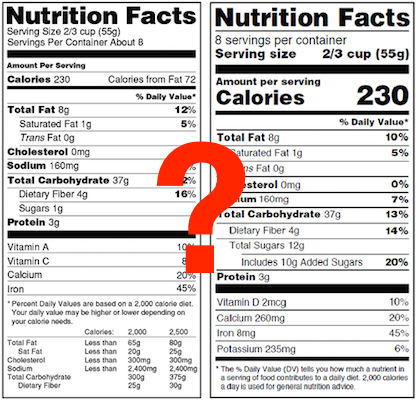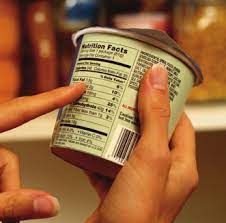Should I Choose a Vertical, Linear, or Tabular Nutrition Label Format?
You may have noticed that different products have their nutrition fact labels displayed in different ways. This usually depends on the type of packaging. For example, a cereal box will have the traditional vertical nutrition label while a granola bar might have a horizontal style label that fits on the flap your tear open. It seems intuitive, but there are FDA rules that govern what type of label you need. We'll go over the basic (and more exotic) nutrition facts label formats as well as when each is appropriate. And, if you want, we have free nutrition label templates where you can enter your values and download instantly.
The FDA Label Format Rules in a Nutshell
The rules are fairly well laid out with diagrams in the FDA guide to label formats and options, if you want to read the FDA documentation (beware that for a document on formatting, the FDA guide is very poorly formatted).
In a nutshell, there are three primary nutrition label formats: vertical, tabular, and linear.
- If you have space for the vertical label on your packaging, use the vertical label
- If you don't, then try the tabular label
- If there isn't space for the tabular label, use the linear label
The FDA Label Format Rules Cracked Open
The main factor determining the label format is "total area available to bear labeling". If you want to follow our explanations with our sample nutrition fact label, you'll get way more out of this.
If you have more than 40 square inches available you must use the vertical label, provided that you have vertical space to fit it up to and including the declaration of vitamins (approximately 3 inches). There is a footnote at the bottom of the vertical label that can be removed if you don't have space for it. Removing the footnote is an option if you have less than 40 square inches available.
If you have more than 40 square inches available but don't have the vertical space to fit the vertical label, you should use the full tabular nutrition label format. If you have less than 40 square inches available, the tabular nutrition label format can be used with the footnote removed, saving a bit of horizontal space.
If you have less than 40 square inches available and your packaging can't accommodate either the vertical or tabular labels, you can use the linear label. Furthermore, the nutrient names can be abbreviated to save further space.
If you have less than 12 square inches available and do not make any nutrient claims on your packaging, you may omit the nutrition fact label entirely. However, you must provide a contact (address or telephone) for consumers to inquire about nutritional information.
The FDA actually provides a decent (but ugly) chart summarizing the options.
These three labels will cover 90% of labeling situations, but there are also some other options, which we discuss below.
Additional Label Options
Some products may qualify for a variation on the labels described above, which is called the Simplified Format. The simplified format may be used if eight or more of the following nutrients are present in "insignificant amounts": calories, total fat, saturated fat, trans fat, cholesterol, sodium, total carbohydrate, dietary fiber, total sugars, added sugars, protein, vitamin D, calcium, iron, and potassium. (For labels for infants and kids up to the age of 3, the threshold is six of these nutrients: calories, total fat, sodium, total carbohydrate, dietary fiber, total sugars, added sugars, protein, vitamin D, calcium, iron, and potassium.) The FDA defines "insignificant amount" (for everything except total carbs, fiber, and protein) as the amount that allows you under their rounding rules to declare zero in the nutrition label. For the total carbohydrate, dietary fiber, and protein, "insignificant" is an amount that allows a declaration of "less than 1 gram".
There is a simplified format for the vertical, tabular and also linear labels. Using the ReciPal nutrition labeling tool, you'll see an option for the simplified format only if your product qualifies for it.
There are separate nutrition fact labels that should be used if your product is intended for children under 4 years of age. One label is for children less than 2 years of age, and another label is for children less than 4 years of age.
A less common label is the Dual Declaration Format, which is used for products such as baking mixes. This label will provide nutrition facts for the raw baking mix as well as the baked version (after adding milk, water, and any other required additions).
The Bilingual Format should be used when the product name is presented in another language to bring it to the attention of consumers who speak that language. Products whose names are recognized ONLY in another language do not need to use the bilingual format (for example, salsa, croissants, rigatoni, etc.). ReciPal does not currently support this label, but we will soon!
The ReciPal Approach
One of the nice things about our nutrition labeling software is that you don't have to know ahead of time exactly what label you need. You can pick and choose formats, see what they look like, and your label will dynamically update itself. All our label options are also well documented right where you choose them, with popups explaining when each option is suitable.
If you haven't yet, try our sample label that let's you play with all the options and get a feel for the different label styles.






